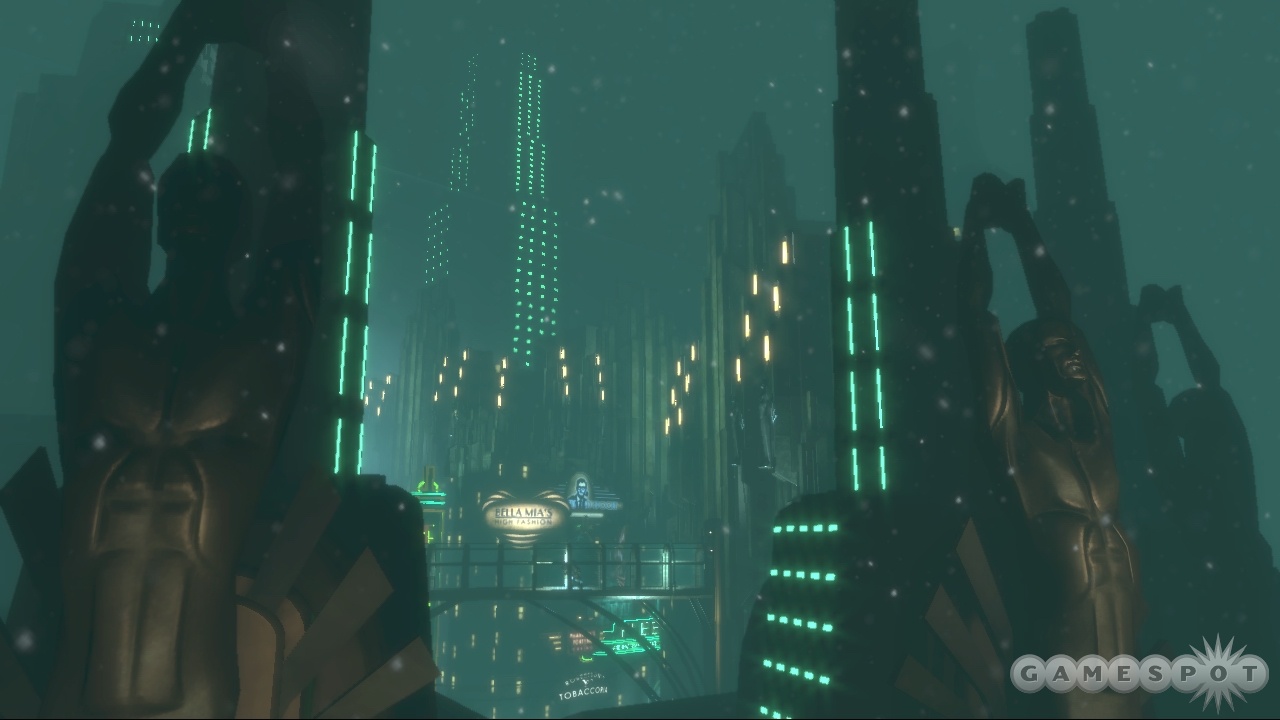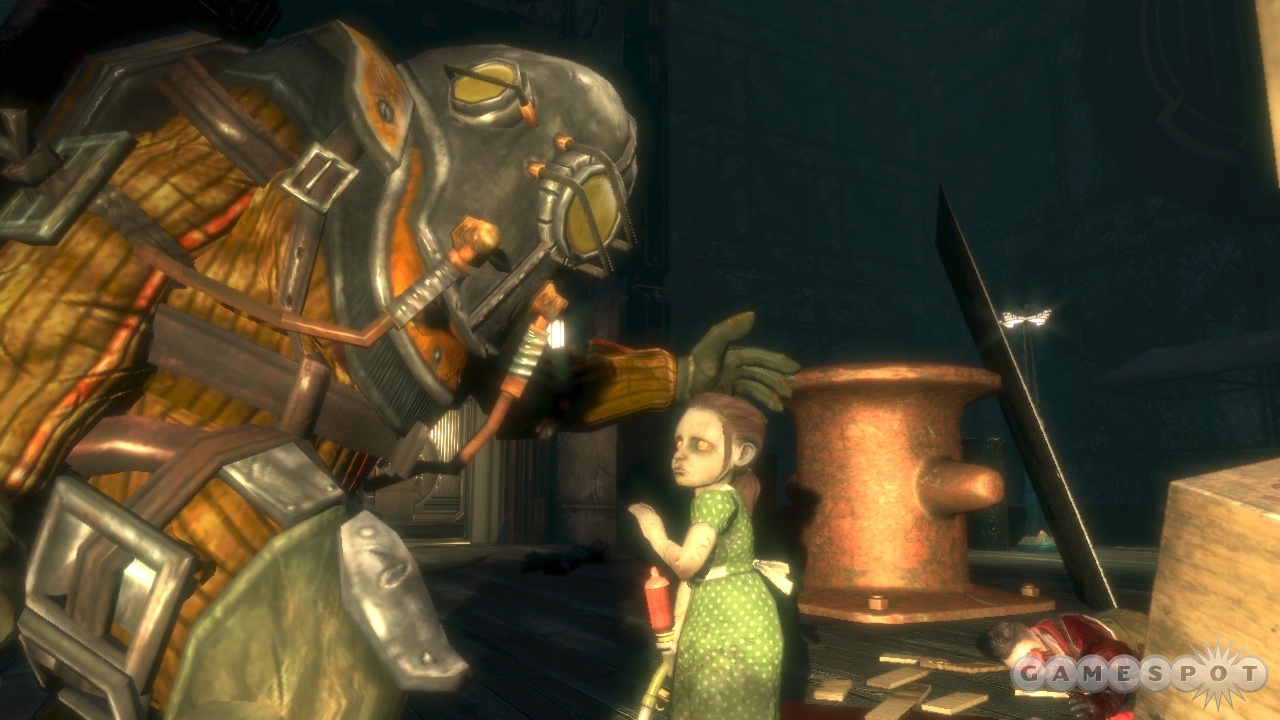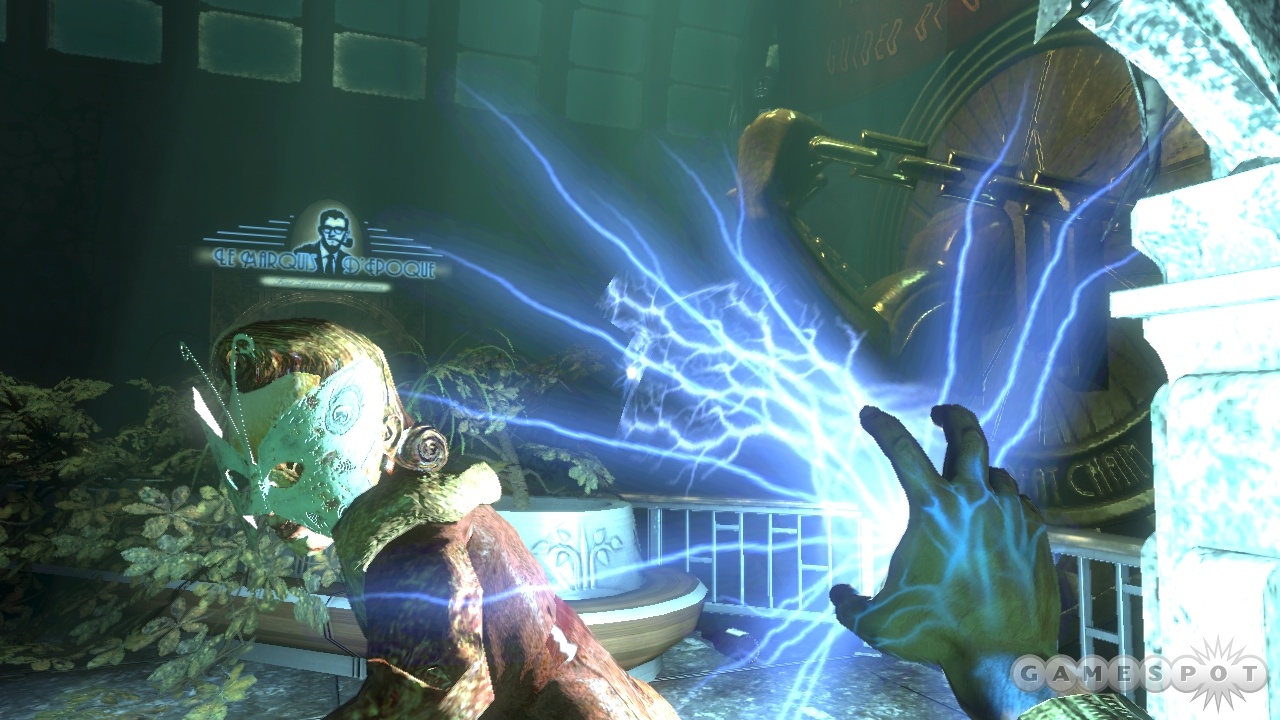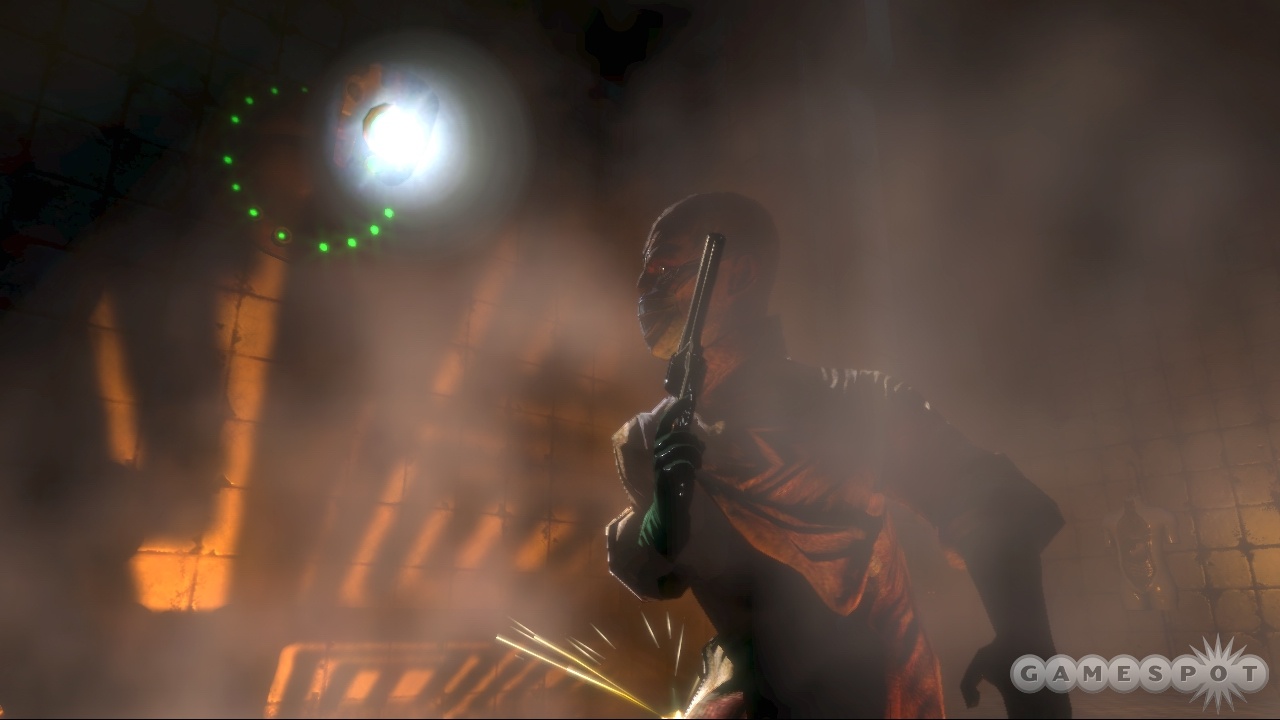BioShock Hands-On
After years of anticipation, we finally got to play the first two hours of Irrational's highly awaited action role-playing game, and we weren't disappointed.
Ken Levine and the BioShock team at Irrational Games have pulled a fast one on Electronic Arts. The 800-pound publishing behemoth may own the rights to the System Shock name, which prevents Levine and company from directly following up their exemplary second installment in that famous sci-fi action-adventure series. But luckily, EA can't copyright the distinctive gameplay mechanics and uncanny sense of atmosphere that made System Shock 2 such a classic. Irrational has brought those elements fully to bear in its new game, which has already been called a spiritual successor to System Shock 2 almost ad nauseam since it was announced nearly three years ago. But it's an appropriate label: Gameplay-wise, this is System Shock 3 in all but name. And so what if they had to come up with an original storyline to make this game? A declining undersea art deco utopia sounds a lot more interesting than a boring old spaceship to us any day.
We know BioShock will tickle the fancies of System Shock 2 fans the world over because we were fortunate enough to sit down with an Xbox 360, the latest game build, and a pair of headphones to actually play the first two hours straight from the title screen. Taking a cue from the old "if it ain't broke..." adage, Irrational has simply mapped System Shock 2's core narrative and gameplay concepts onto a new storyline, as well as a fresh milieu. The list of similarities is long and striking. BioShock too will see you happen upon a nearly deserted environment ruined by a recent, disastrous sequence of events. Again, you'll piece together the story of what happened as you uncover the recorded audio logs of the poor souls who perished--or worse--in the catastrophe. And again, you'll be remotely guided through danger by a mysterious informant. This time, your informant is a man named Atlas, whose identity wasn't revealed during our brief time with the game, but whose wife and children we do know are imperiled somewhere within the underwater complex where the game takes place.

While System Shock 2 merely presented a serviceable sci-fi backdrop, BioShock's unique setting draws on mid-20th century influences in political ideologies, architectural design, pop culture, and music to create the ambitious, failed world of Rapture. The game doesn't bother with such details as your own identity; all you know at the outset is that it's 1960, and you're on an oceanic flight that's suddenly gone extremely wrong. After a brief opening cinematic depicting the crash, we found ourselves swimming in the mid-Atlantic amidst flaming airplane wreckage, bobbing luggage, and charred corpses. In the shadow of all this wreckage was a gigantic lighthouse rising inexplicably and ominously from beneath the waves. What else is there to do in such a bizarre situation but climb up the barnacled steps and go inside for a look?
As you descend beneath the sea in a retro-styled diving bell, you'll be treated to an old propaganda-film-style reel explaining what has just happened. It's all the work of Andrew Ryan, a strong-willed mad scientist type who tired of laboring for the benefit of others and set out to create his own society "where the great will not be constrained by the small," as he puts it. Ryan gathered only society's best and brightest; the finest scientists and artisans to populate his utopia. It was all made possible by Adam, the genetically mutable substance Ryan discovered, which has the power to imbue ordinary human beings with extraordinary powers. Want to achieve superhuman strength? Master the art of pyrokinesis for your next barbecue? Mix up an Adam cocktail, and it's all yours.
As you investigate Rapture's sprawling, doomed infrastructure, its crumbling art deco facades, and leaky corridors, you'll uncover the secrets of what went wrong. Stepping out of the diving bell, you'll see signs of a struggle: blood splattered across dropped picket signs condemning Ryan for apparently declaring martial law and confining residents to remain inside the city. As you'd expect (from what we saw so far), it all comes back to the Adam. We'd barely set foot onto the first platform of the city proper before running into a splicer, which is one of BioShock's common enemies and one of Rapture's former residents. As Atlas will quickly fill you in, it seems that overuse of Adam turns the subject into a crazed monster that fiends for--what else--more Adam. Imagine a crazed junkie dying to get his hands on a fix; only this junkie can throw fireballs out of thin air and move large objects with his mind. And those are just the basic enemies.

Luckily, the perils of Adam aren't enough to dissuade your own character from absorbing the occasional genetic superpower himself. In addition to the trusty wrench you'll immediately find, you'll soon discover a plasmid, which is BioShock's term for a genetic power-up. This gives you the electrobolt ability, which lets you throw an arc of electricity a few feet in front of you. Like all of the game's Adam-given abilities, electrobolt will come in equally handy in puzzle-solving and combat situations. For instance, you can use it to reenergize some controls for doorways or the many vending machines scattered throughout Rapture. But it's just as useful for stunning an enemy for a few seconds, during which one healthy whack from the wrench will put your enemy down for good (a combo that remains potent even after you start finding revolvers, shotguns, and Thompson submachine guns). Managing to sneak up on a couple of splicers wading through a pool of water and electrocuting them both in one move before they ever knew you were there can also provide a delightfully satisfying result.
Veterans of System Shock 2 will feel surprisingly at home when they take the controls of BioShock. That's because the controls, and more importantly your interface with the world of Rapture, are largely identical to those of Irrational's classic. You can pick up a bevy of helpful (and occasionally harmful) objects in the environment. You can also search every corpse, as well as many of the containers, safes, or drawers you find, for more items and currency. There's even a hacking minigame that slashes the prices on many vending machines or wins automated defenses to your side. (Only this time, it's a hydromechanical setup that requires you to fit pieces of piping together to route water from points A to B.) And of course, you'll quickly find yourself in possession of more genetic powers than the electrobolt: We picked up flamethrowing and telekinetic abilities just in the first few areas of the game. You'll only get to carry a couple of abilities at a time, so choosing your best powers at a machine called the gene bank will become a large part of strategizing for future encounters.

Luckily, per the development team's mission statement for BioShock, you'll be encouraged to tackle those encounters in any number of ways. We got to see an Irrational team member play through a later sequence in the game from an area called Port Neptune three separate times, taking a different tack on each run. Heading into an area filled with splicers, security turrets, and even a big daddy (those burly diving-suited thugs charged with protecting the ghastly, Adam-collecting children called the little sisters), the player first tried to simply gun down all opposition but naturally didn't survive very long for his efforts.
But the second time through, he snuck up and hacked the turret. Then he turned it away from himself and toward his enemies. While they were busy with that, he showed the audience how he could set a splicer on fire with pyrokinesis. Later, when the enemy jumped into a pool of water to extinguish the flames, he could electrocute it for the final kill. On the third play-through, the player used some sort of projectile pheromone to send the big daddy into a rage, causing it to fight with the nearby enemies while the player was free to use environmental tools as he saw fit. This primarily involved planting a handful of sticky bombs on a nearby barrel, then using telekinesis to hurl it across the room as a big and highly explosive bomb. There will be numerous such scenarios throughout the game where you'll be able to choose how to approach a combat scenario. That is, if you decide to fight at all.
BioShock will offer you a degree of moral choice too. As it turns out, those little sisters are still real little girls deep down. If you do manage to bring down a big daddy, which is no mean feat, we can assure you that you'll have it in your power to restore the little sister to the innocent little girl she used to be, allowing her to run off into the bowels of Rapture and find a safe hiding place. Of course, you could also be a big jerk and just kill her, allowing you to harvest all that delicious Adam for yourself. But Levine assured us that taking the moral high road on this particular issue will have story- and gameplay-relevant consequences for you later on in the game.
Like most of the game's secrets, Levine and company aren't talking about those consequences. There were a great many things that actually had us scratching our heads during our brief demo. How did Ryan discover Adam? And where did it come from? Who is this Atlas guy? (We're pretty sure he won't turn out to be Shodan, at least.) How did he know about the plane crash, not to mention the identity of your own character? Speaking of your enigmatic avatar, why does he have what appear to be chains tattooed across his wrists, which were only briefly visible during one plasmid-consuming animation? Who's inside those big daddy diving suits, anyway?

At least BioShock's cinematic and narrative qualities are as compelling as we'd hoped, so you'll get to fully enjoy the impact of each of those secrets you uncover. Like System Shock 2, you'll occasionally see ghostly afterimages that play out often-macabre previous events for your grim viewing pleasure. As mentioned, those audio logs that were so effective in establishing System Shock 2's storyline are back here. Again, they'll run the gamut from Rapture's most brilliant (and often twisted) scientific minds to Ryan's inebriated socialite consort whining about the excesses of Adam at a New Year's celebration. You should also expect lots of tense scripted events to occur within the gameworld. (The savage first appearance of a big daddy is one moment in particular we aren't likely to forget soon.)
The development team is in the final stages of balancing gameplay and applying artistic polish to BioShock. The game is looking incredibly rich, thanks to the Unreal Engine and Irrational's own modifications to it. Currently, the game is slated to hit both the Xbox 360 and PC in August. For those of you wondering how BioShock will straddle PC and console interfaces when similar past games have famously failed to do so, Levine offers a novel but simple solution: Two separate teams of designers are working on the controls and interfaces for each version. And after the extremely impressive first bit of BioShock we've tried so far, we may just have to play through both of them.
Got a news tip or want to contact us directly? Email news@gamespot.com
Join the conversation